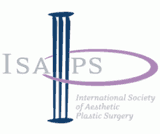- The diagnosis of the cause of the symptoms which result from complications related to the implant (implant rupture, capsular contracture, and implant translocation).
- The diagnosis of a symptomatic disease inside the tissue surrounding the implant (infection, surgical wound infection, abscess, hematoma).
- Screening tests for breast cancer in women aged 40 years and over. Depending on the clinical question each time, imaging techniques vary.
IMAGING STUDIES AND COSMETIC BREAST SURGERIES
 Breast enlargement constitutes a common surgical procedure appealing to more and more women in our days.
The most common causes making a woman decide on the procedure are either aesthetic (small breasts, breast asymmetry, sagging after weight loss or breastfeeding) or for restoration-repair of the breast following a mastectomy.
During the procedure, the implants are placed either under the glandular tissue (subglandular) or between the pectoralis major or minor muscle.
Breast enlargement constitutes a common surgical procedure appealing to more and more women in our days.
The most common causes making a woman decide on the procedure are either aesthetic (small breasts, breast asymmetry, sagging after weight loss or breastfeeding) or for restoration-repair of the breast following a mastectomy.
During the procedure, the implants are placed either under the glandular tissue (subglandular) or between the pectoralis major or minor muscle.

Figure 1
Usually, several imaging tests are conducted after the placement of breast prostheses (implants).
The reasons behind the conduction of imaging tests in patients who underwent breast repair surgeries may include:
 Ultrasonography s the principal diagnostic method in the investigation of undesired results after the placement of breast implants.
Ultrasonography s the principal diagnostic method in the investigation of undesired results after the placement of breast implants.
It provides non invasive tomographic imaging of high diagnostic value, using non-ionizing radiation (NIR) on women. It is a painless, fast and low cost method delivering immediate results. Using high-frequency heads, both breasts and axillary cavities are thoroughly examined.
Various complications may be identified, such as presence of postoperative hematoma; in this case, ultrasound-guided drainage is performed. In addition, the doctor examines the extent of the surgical wound infection and dehiscence. Another advantage of the method is that the assessment of a suspected breast mass is not visually limited by the implant. The imaging test can detect small, non palpable lesions, and, to a great extent, determine the nature of the damage (differentiation of cystic lesion from solid tumors).
The implant is well-rounded and anechoic. On the posterior segment sound reflections are checked. When the implant type is known, we can assess the rupture site (occurring spontaneously or due to trauma). The rupture site is depicted as ‘noisy’ echogenic area (snowstorm), contacting the implant capsule.



Ultrasonography is a painless, bloodless and radiation-free method which delivers reliable and fast results. It deploys the properties of the ultrasounds for the studying of the texture and dimensions of tissues which are not directly visible in clinical examination..
Breast MRI is a newer imaging technique. The images are obtained using a single mammary coil which guarantees high signal-noise ratio. It uses specific sequences which aim at depicting the silicone and provide simultaneous water signal reduction.
Using these specific sequences and specialized assessment criteria, breast MRI constitutes the most accurate method in evaluating the integrity of the implant. Rupture sensitivity amounts to 80-90% and its specificity to 90%. The imaging study depicts the rupture site and the extent of silicone leakage.
Breast MRI (ΜΤΜ) may be used upon the manifestation of symptoms related to leakage from the implant, such as localized inflammation or the formation of silicone granulomas. In patients with implants following a mastectomy due to breast cancer, breast MRI can be used in the examination of possible disease recurrence or as a postoperative screening test. The implant does not affect the sensitivity of the tes


Mammography is performed with the standard oblique or craniocaudal projections which include part of the implant and additional images with the implant moved. In this way, the mammary gland is compressed and better depicted. Further images are acquired for diagnostic purposes, when necessary.
These several mammography views exhibit any calcifications formed on the fibrous capsule, located on the implant surface, as well as any creases the implant may manifest.



Figure ΙV
Thus, according to each clinical question, we choose the applicable imaging test to help us deliver the diagnosis and plan further treatment schemes.
Filippos Giannilas, M.D, PhD
Radiologist
Chief of the Department of Radiology, Bioclinic, Athens
Dr Kapositas’s associate since 2000
Breast augmentation. Photos Before - after












